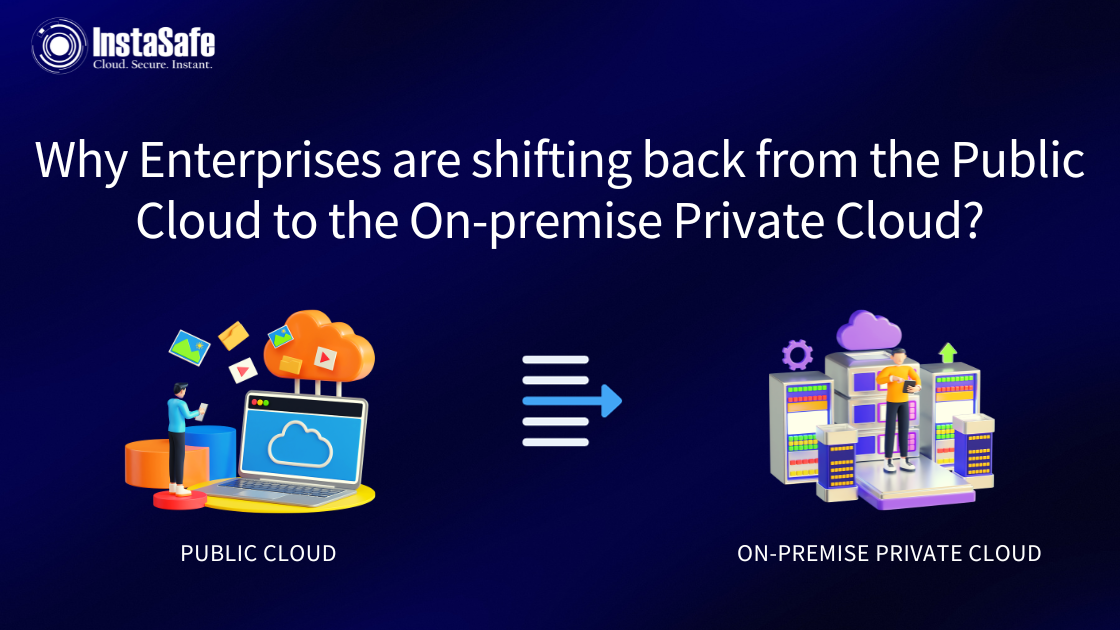Why Enterprises are shifting back from the Public Cloud to the On-premise Private Cloud?

Introduction:
The last decade has seen the emergence of a large number of SaaS companies and few of them became Unicorns (Billion Dollar+ ). One of the key drivers of growth for these SaaS companies was public cloud infrastructure which helped them to scale and manage their IT infrastructure and cost effectively. However, with the widespread adoption of cloud services with an increase in data traffic, the cloud cost also started rising sharply. Enterprises have started feeling the pinch of increased cloud costs and other challenges. In this article, we will try to explore why enterprises are shifting back from public cloud to on-premise private cloud setups.
Rise of Public Cloud Infrastructure:
According to a report by cybersecurity ventures, the world will produce more data in the next 3 years than it produced in the last 30 years and it is expected that half of the data will be residing in the cloud. This is the scale of cloud infrastructure that has reached today.
Currently, the major public cloud service providers namely Amazon, Microsoft, and Google generate more than 200B USD revenue from cloud service business and they expect it to increase by more than 28% annually. The ability to provision resources on-demand, pay-as-you-go pricing models, and the elimination of the need for extensive physical hardware investments have made public cloud an attractive option for businesses of all sizes.
Current Challenges with Public Cloud
Amidst the several benefits that cloud infrastructure offers, the cost of cloud computing has started pinching to most of the enterprises. As per IDC cloudpluse 2019 report, 85% of organizations have reported that they performed some activity related to cloud repatriation.
Main reasons are driving organizations to shift from cloud to on-premises data center include
- Cost Management: Cloud cost for a workload is composed of various components which Server Instances, Type of Virtual Machines, Storage Provisioned, actual storage used, Data transfer (both Ingress and Egress), network components and additional components like IAM, support costs. As an organization’s workload increases, the cloud cost increases more than the initial expectations which cause dissent with the cloud services.
- Availability: Public cloud are also subject to outages. Though cloud service providers provide their Service Level Agreement (SLA) on uptime, organizations have to remain at the mercy of cloud service providers. With on-premise, organizations can have better control of their data centers and its availability.
- Skills: Each public cloud service provider have their own configuration techniques and promote their own cloud certification for IT administrators for skilling up. Skill gap can impact the performance and optimization of cloud infrastructure.
- Data Security: All cloud service providers suggest security is a joint responsibility of organization and cloud service providers. Although there are security controls provided within the cloud infrastructure, it also depends on the security configuration. There have been multiple instances where a particular configuration is not set properly and data leaks have occurred. For this reason, some organizations still feel that public cloud doesnot offer adequate security measures
- Performance and Latency: For applications with high-performance requirements or those dealing with large datasets, latency can be a significant issue in the public cloud. Some enterprises find that maintaining an on-premise solution provides better control over performance.
- Vendor Lock-in: As enterprises become more dependent on a particular cloud provider's ecosystem, the challenge of vendor lock-in becomes more significant. The cost and complexity of migrating applications and data from one cloud provider to another can be a barrier.
When to stay with Public Cloud vs On-Premise Private Cloud?
The way the public cloud was hyped over the years that cloud is the only future, it is not so as it seemed to be. Organizations can take advantage of both public and on-premise cloud setup based on their challenges and needs.
Organizations can stay with public cloud if:
- Organization is a small and medium businesses and they have few IT resources to manage their cloud infrastructure. In that case, they can spin up new servers faster and deploy faster.
- If the organization workload increases or fluctuates, and it requires high availability, then public cloud is best suited for scalability and high availability.
Organizations can shift from public cloud to private cloud if:
- Public cloud cost expense has gone beyond what private cloud would have cost.
- Organizations have steady workloads and have less fluctuating demand.
- Workloads that require large quantities of data to be managed.
- Security and compliance specific requirements that can easily be achieved using private cloud
What is the Way- Forward
Finding the optimal cloud strategy involves a thorough assessment of an organization's specific needs, compliance requirements, and long-term goals. Hybrid cloud solutions, combining the strengths of both public and private clouds, are gaining popularity. This approach allows enterprises to maintain critical workloads on-premise while leveraging the scalability of the public cloud for less sensitive operations.
As technology evolves and cloud providers address challenges, the decision-making process for enterprises will continue to evolve. Organizations must stay vigilant in monitoring the evolving landscape and adjust their cloud strategies accordingly. The key lies in finding the right balance that aligns with business objectives, regulatory requirements, and the ever-changing demands of the digital age.
About InstaSafe Zero Trust Solution
InstaSafe Zero Trust Solution is a comprehensive secure access solution for modern hybrid workforce enabling safe and secure access of business-critical applications across multi cloud environment. Zero Trust solution ensures that only right users with authorized devices can securely access the right applications with complete visibility and granular access control. InstaSafe Zero Trust solution can be deployed in Hybrid Cloud environment ( both public cloud environment (Amazon, Azure, or GCP) and On-Premise DC)
To book a product demo, you can fill the form using this link https://instasafe.com/book-a-demo or email us at sales@instasafe.com
Key Products
MFA | I&AM | ZTNA | Zero Trust Application Access | Secure Enterprise Browser
Key Features
Single Sign On | Endpoint Security | Device Binding | Domain Joining | Always On VPN | Contextual Based Access | Clientless Remote Access | Device Posture Check
Key Solutions
VPN Alternatives | DevOps Security | Cloud Application Security | Secure Remote Access | VoIP Security
